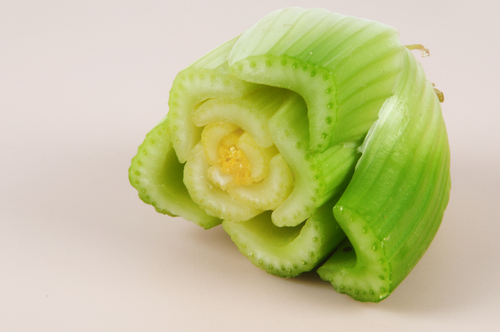
Grow veggies from scraps! Via Shutterstock
Minimize food waste and reduce your grocery bill by learning to grow a vegetable garden from scraps! It takes some time and effort, but no more than if you were planting vegetables from seeds. A fellow gardener recently showed me how to grow celery from scraps and I’ve since fallen in love with this method of growing food and have researched other veggies that can be grown from scraps.
Keep in mind that the quality of the “parent” vegetable scrap will help determine the quality of the re-growth. For this reason, I like to splurge on organic produce to start my veggies. Stay away from genetically modified veggies as they seldom grow.
Here are 18 vegetable garden items you can grow from scraps.
1. Celery – Eat the celery stalks, but leave the root end intact. Then fill up a container with water and soak the white end. Once the end develops leaves and roots grow in the bottom, transfer it to soil. In a couple of weeks you’ll have celery.
2. Romaine Lettuce – Never buy another head of lettuce again! Follow the instructions above for regrowing celery. Make sure to place the Romaine ends near a sunny window. Spray the top with water occasionally to keep the top moist. Roots and new leaves will appear after a few days and you’ll be able to plant in your garden.
3. Bok Choy – Use the same technique as celery and romaine lettuce.
4. Potatoes – Allow potatoes to grow “eyes”. Once the potato has many of them, chop it up into 2 inch square pieces. Make sure each piece has one to two eyes. Leave the potatoes out in room temperature for a couple of days to allow the cut surface area to dry out. This will prevent the pieces from rotting in the ground. Once dry, plant them in the soil.
5. Sweet Potatoes – The process to grow sweet potatoes is similar to growing potatoes, but instead of cutting it into chunks, plant it whole.
6. Garlic – You only need a single clove to regrow an entire garlic plant! Find an area that gets direct sunlight and place the end with the root down into the soil. Wait for the garlic to root itself and begin to send up new shoots. Once it sprouts shoots, cut them back to allow the plant to put all its resources into growing a garlic bulb. Garlic sprouts are edible so enjoy!
7. Shallots – Follow the same technique as garlic.
8. Onions – With onions you’re going to use the root end. Leave about a half inch from the root intact. Plant the onion end in a sunny place and cover with top soil. Don’t forget to keep your soil moist!
9. Avocados – Growing avocados from kitchen scraps takes a looong time. Avocados grow in trees after all. Once you’ve scooped out the creamy flesh, take the seed and wash it clean. You’ll have to stick three or four toothpicks to suspend it above a glass of water. You’ll only want to cover about an inch of it with water. Place the container into a warm area with filtered sunlight and add water as needed. Within 2 – 6 weeks, a stem and roots will begin to sprout. Once your avocado has a stem that is 7 inches long cut it back to 3 inches. When its roots are thick, take out the toothpicks and place the plant into a rich humus soil. Leave the seed half exposed as if you were growing a flower bulb.
10. Pineapples – Eat the yellow part of the pineapple and remove the green top, or crown. Make sure the top is not brown or yellow. You want it to be green. You’ll need to save the crown to grow pineapples from scraps. You can try twisting it off or use a sharp chef’s knife. Then strip the crown of some leaves to exposed the stem. Allow to dry for about a week. Place the crown in a glass of water until the roots start to grow. Plant the crown in soil.
11. Mushrooms – Fungi are trickier to regrow, but it can be done! Just remove the head from the stem, then plant the stem in nutrient-rich potted soil. Leave the top exposed and place them in filtered light during the day and in a cool temperature at night.
12. Cabbage – Use the same technique as celery.
13. Ginger – Instead of letting a piece of ginger shrivel in your fridge, put it in a pot of soil. The ginger will be growing shoots and roots. Make sure to place it in an area with filtered light.
14. Turnips – Cut off the tops and place in a container with water. New green tops should start growing in a few days. The same is true for other root veggies like carrots, beets, radishes, and parsnips.
15. Scallions – Regrowing scallions is simple! Stick the root end in a glass of water and place it in sunlight. Change the water every now and then and wait for them to grow.
16. Leeks – Use the same technique as scallions.
17. Lemongrass – Use up lemongrass as usual, but save the root end. Place it in a glass of water to grow. it should be ready to plant within a week or two.
18. Basil – Choose a 4-inch stem and cut just below a leaf node (the part of the stem where new leaves sprout) using a sharp blade. Don’t use scissors! Place in a glass of water and make sure none of the leaves are underwater. Leave the glass in a bright spot that’s not too hot. Roots will start to form on the stem and once they’re 2-inches long plant in soil. Place in direct sunlight and water.


I did the celery thing and it seemed like it took forever for it to grow to a reasonable size. There was actually more leaves than celery, but the leaves are very tasty too!! Have tried the avocado to no avail…..I will try the romaine lettuce though, since organic lettuce is so expensive! We did grow lettuce from seed, and we had 15 or so plants, so I didn’t buy lettuce for about 3 months. Because we didn’t stagger the growth, we had to give away about 6 heads, but all is good…….now that it is so hot in Southern California, the remaining 5 heads are bolting – so we’ll save those seeds and plant again when it gets cooler in the fall!
@Michelle Sounds like you’re a seasoned gardener! I also think celery leaves are delish. Use them in soups and even stuffing.
I have done the avocado and now have a beautiful plant!! am now doing celery, scallions, red onion and lettuce to see if I can have the same success
Interesting article! Thanks for the info